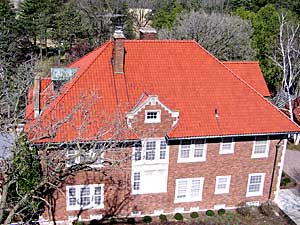|
Audio
Photos
Resources
|
April 15, 2005
 |
| The main building of the Anderson Center in Red Wing, as seen from the water tower on the grounds. (MPR Photo/Greta Cunningham) |
Red Wing, Minn. — The first thing you notice about the Anderson Center is the large tower. Originally built as a 25,000-gallon water tower, its "witch's hat" top overlooks Highway 61 just north of Red Wing. The tower was built by Alexander P. Anderson in 1915.
"This was the tallest man-made structure here for a long long time," says Anderson's grandson, Robert Hedin. "I can imagine in the old days, long before skyscrapers, people were really quite amazed by how high they could get and the views of the whole area."
Hedin is responsible for turning the center into an artist residence in 1995. It's hosted 320 writers and artists over the past decade, from 30 states and 20 foreign countries.
The sprawling compound looks like a combination of a typical Minnesota farm homestead and a collage campus. It features stately Georgian brick buildings, a greenhouse, an ice house, a sculpture garden and many barn-like buildings used as artists studios.
Hedin and his wife took control of the family compound after buying it back from the Red Wing School District. They decided to turn it into an artist residence to help boost the quality of life in Red Wing.
The artists apply to become six-month residents at the Anderson Center. Five are chosen, and each receive free room and board, and use of the compound's 330 acres. Hedin says the Anderson Center gives these artists something else.
"We provide two very important things for writers and artists -- the quiet, and the space necessary to do really fine work," Hedin says.
Minnesota writer Jim Heynen stayed at the Anderson Center last September as he was working on his latest novel. Heynen teaches writing at St. Olaf College, and says the lack of television, mail delivery and reliable telephone service helped him to be very productive. He says he wrote about 200 pages, or two-thirds of his new novel, during his stay.
"I'm not sure exactly why that happens. When you get away from it all and just go into -- you can't even call it seclusion, because there were others around. In fact it almost felt better than seclusion, because there was the awareness that others were doing their work too," says Heynen.
Jim Heynen says he often climbed to the top of the tower with the witch's hat to improve his cell phone reception and to take in the views. He says the tower also helps artists get inspired.
"It's that illusion of ascendancy," says Heynen. "You feel, 'Here I am at this glorious height. Certainly my ideas have to come with me.'"
Alexander Anderson built what he called "Tower View" during World War I as a place to raise his family and conduct experiments -- experiments which would influence the way Americans ate breakfast.
Anderson, the son of Swedish immigrants, perfected a way to make puffed rice cereal. He sold the process to the Quaker Oats Company. His grandson, Robert Hedin, says the cereal was introduced at the 1904 St. Louis World's Fair and became a sensation.
"In many ways the puffed rice and the puffed wheat that came out of all of his inventions was the very first fast food, and it revolutionized the way Americans ate breakfast," says Hedin.
Visitors to the Anderson Center can tour the buildings and grounds -- and wander through the many tunnels in the complex. Most tour groups end up at the base of the tower, and climb the 76 steps to the top of it.
The narrow, winding staircase leads to a round rotunda at the top of the tower. Many large windows look out over the grounds, and Highway 61 which runs past it. There's also an outdoor deck, which provides even better views.
"We're just a short way from A.P. Anderson's original birthplace," says Hedin from the top of the tower. "It was a farm about three miles away. He was born in a dugout."
Alexander Anderson stayed in the area, working on the farm, until he was 28. He left in 1890 to study at the University of Minnesota, then in Germany. He eventually invented the process to create puffed cereal, and the rest, as they say, is history.
"He was a man filled with a great deal of intellectual curiosity, a great deal of energy, and obviously, inventiveness," says his grandson Robert Hedin. "We here at the Anderson Center are both honored and very humbled by the past, and we try to carry on that spirit of creativity and inventiveness in everything we do."
Robert Hedin says he and everyone at the Anderson Center are proud of the artists and writers who've found the time and inspiration to create great works of art.
"For me personally, it's been one of the great joys of my life -- to see this wonderfully old complex come back alive, and used for a purpose that I think holds a great deal of importance," says Hedin.
The next group of Anderson Center residents begins their stay in May.








